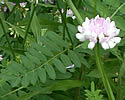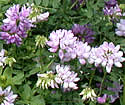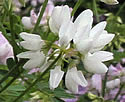Securigera varia (Crown Vetch)
| Also known as: | Purple Crownvetch |
|---|---|
| Genus: | Securigera |
| Family: | Fabaceae (Pea) |
| Life cycle: | perennial |
| Origin: | Eurasia, N Africa |
| Status: |
|
| Habitat: | part shade, sun; fields, along roads |
| Bloom season: | May - September |
| Plant height: | 1 to 2 feet |
| Wetland Indicator Status: | none |
| MN county distribution (click map to enlarge): |  |
| National distribution (click map to enlarge): |  |
Pick an image for a larger view. See the glossary for icon descriptions.
Detailed Information
Flower: 

![[photo of flowers]](/udata/r9ndp23q/pink/crown-vetch_0630_150341-t.jpg) 1-inch round clusters of up to 25 irregular pink flowers. Individual flowers are about ½ inch long and ¼ inch wide, a typical shape for a member of the pea family, with pink upper and pale pink to white lower petals. Each flower cluster is at the end of a long naked stem arising from a leaf axil.
1-inch round clusters of up to 25 irregular pink flowers. Individual flowers are about ½ inch long and ¼ inch wide, a typical shape for a member of the pea family, with pink upper and pale pink to white lower petals. Each flower cluster is at the end of a long naked stem arising from a leaf axil.
Leaves and stems: 

![[photo of leaves]](/udata/r9ndp23q/pink/coronilla-varia-crown-vetch_0710_111500-t.jpg) Leaves are 2 to 4 inches long and compound with 12 to 25 leaflets. Leaflets are up to ¾ inches wide and 1½ inches long, rounded at both ends, often with a small tooth-like point at the tip. Stems are multiple from the base, sprawling, hairless to sparsely short-hairy, branched, and ridged.
Leaves are 2 to 4 inches long and compound with 12 to 25 leaflets. Leaflets are up to ¾ inches wide and 1½ inches long, rounded at both ends, often with a small tooth-like point at the tip. Stems are multiple from the base, sprawling, hairless to sparsely short-hairy, branched, and ridged.
Fruit: 
![[photo of fruit]](/udata/r9ndp23q/pink/crown-vetch_0726_155014-t.jpg) Fruit is a finger-like cluster of thin pods that ripen to a deep reddish brown. Each pod is up to 2 inches long, has a “tail” at the tip, and contains up to 12 seeds.
Fruit is a finger-like cluster of thin pods that ripen to a deep reddish brown. Each pod is up to 2 inches long, has a “tail” at the tip, and contains up to 12 seeds.
Notes:
Crown Vetch, formerly Coronilla varia, is a creeping plant that was originally cultivated as a ground cover to prevent erosion and has been widely planted along roadsides and embankments. It is a quick spreader and can form large masses, creating dense monocultures where little else grows. It spreads both vegetatively through spreading rhizomes and by seed, and is exceedingly difficult to remove once established. It not only invades disturbed areas and roadsides, but also high quality habitat. It is much more widespread in the state than the distribution map indicates, since it was intentionally planted along many highways and county roads in the past and is still sold commercially.
Native Plant Nurseries, Restoration and Landscaping Services ↓
More photos
 Crown Vetch plants
Crown Vetch plants a mass of Crown Vetch
a mass of Crown Vetch roadside monoculture of Crown Vetch
roadside monoculture of Crown Vetch emerging in early April
emerging in early April atypical white flowers
atypical white flowers
Photos by K. Chayka taken in Ramsey and Stearns counties. Photos by Peter M. Dziuk taken in various locations around Minnesota.
Comments
Have you seen this plant in Minnesota, or have any other comments about it?
on: 2009-07-01 20:56:45
Hi I saw American vetch on the side of the road this evening and on the other side I saw a plant that looked very similar to it so I gathered a bunch to identify and it turned out to be purple crown vetch. Do you know why they look so similar and yet one is native and one introduced? I spotted it in white bear lake by bald eagle lake.
on: 2009-07-01 22:03:47
There are a lot of plants that look similar to MN native plants, but are not native. In the case of crown vetch, as I understand it, it was actually engineered, intended to be used for erosion control. It got out of control instead and has become an invasive species.
BTW, unless it's your own property I recommend you take pictures of wildflowers you want to identify later, rather than pick them. You don't know if you're taking something harmful, or causing harm to the habitat. Besides, you could be fined if you're caught taking flowers from public lands.
on: 2010-06-25 17:55:05
Masses of these in several open areas of Oakdale Nature Preserve, often intermixed (but generally out-competing) Bird's-Foot Trefoil.
on: 2010-06-29 15:37:30
I found one of these with opposite and alternate leaves, does that make it a mutant plant?
on: 2010-06-29 20:45:52
There are sometimes unusual variations in species that don't necessarily mean a genetic mutation. Also, if alternate leaves are very close together they might look opposite. And keep in mind that for a species with compound leaves like crown vetch, the attachment doesn't refer to the leaflets, but the entire compound leaf.
on: 2010-07-05 14:16:34
These are growing in a few places on the backside of the college. I also have some growing in my backyard garden.
on: 2012-08-25 15:46:48
I have it growing in my yard. I guess it is time to go yank it out. I love this site found it about a week ago.
on: 2013-07-03 11:12:19
I saw these on the path running through the Twin Cities Army Ammunition Plant in Arden Hills. There is a clump of them on the west path about 4 benches in from the entrance. They are beautiful and I went back today for pictures.
on: 2014-03-20 11:06:45
My mother planted this on lake property in Prior Lake because grass wouldn't grow well. We attempted a water-safe herbicide to clear the entire hill, wanted plants and unwanted, but the vetch came back. It has taken over the whole hill again since our attempt and makes our native plantings struggle to thrive. That said, I like seeing it on highway hills where it blooms so pretty and causes no one harm.
on: 2014-03-20 11:13:08
"causes no one harm" isn't exactly true, if you consider the habitat loss for native bees, butterflies and other insects. A crown vetch monoculture does not support much life.
on: 2014-04-25 14:59:57
The previous owner of our house planted this on the hillside and it completly took over a small field behind the hill. 3 years ago I used Crossbow herbicide and have had to reapply it the past 2 years because plants continue to grow from existing seeds. How long do the seeds survive? Will I ever be free of this pesky plant?
on: 2014-04-25 16:39:37
Bob, I have read that crown vetch seeds are viable for 15 years or more. You have a long road ahead of you. :-(
on: 2014-06-16 17:11:53
Saw a bit of Crown Vetch in a large overgrown mess that is owned by the city. Needless to say they don't do anything about the eyesore but, I noticed the cute flowers and identified them as definitely Crown Vetch.
on: 2014-07-10 19:12:29
Lot's of it, along with more European creeping bellflower than last year.
on: 2014-08-21 11:18:46
This is the worst invasive weed in Minnesota. If you find it in your prairie you must control it because it will take over every native plant and smother it and then turn an ugly brown mat in the fall. Do not be fooled by this pretty flower; it is my worst nightmare. Watch for and identify this plant early and kill it!
on: 2015-06-13 13:46:19
I'm not positive but there is something very similar to this that tends to spring up in the Wildlife Refuge in Bloomington. It lines the trails on either side. It also shows up in Lilydale.
on: 2015-06-25 07:43:48
I started a native savanna praire replanting and the p. crown vetch is the absolute worst to control. It spreads with rhizomes AND seeds. I spend hours trying to stay ahead of it, but just about every day I find more of this fast growing headache!
on: 2015-07-03 17:51:06
Quite common in the sandy areas of southeast Clay County. This is another case of humans moving a plant from it's native range, and then condemning the plant for doing its job too well. My honey bees and the native bumble bees really seem to like the flowers of this plant. Yes, it does tend to form a monoculture. But again, it's all relative when you consider the landscapes we have created in the name of agriculture.
on: 2015-07-14 11:29:18
I know the plant was a vetch, and I think it is Crown Vetch. I will be posting a picture along with a review shortly on Trip Advisor, Pipestone National Monument. If you want I can send a couple of photos your way.
on: 2016-06-04 17:41:19
Found a few plants growing at edge of our wooded area this year. Took pics and compared with photos online of purple crown vetch. Looks like that is what we found. Guess we better get rid of it asap.
on: 2016-06-11 10:27:54
I posted back in 2014 about trying to eradicate the Crown Vetch in the field on our property. It is still a battle. My method over the past 3 years is to mow the field, allow the new vetch plants to grow to 2", and then spray them with Cross Bow herbicide. This works however new plants still germinate in the spring and late summer. Maybe someday it will be gone, just not this year.
on: 2016-07-01 12:31:02
This appears to be growing in patches throughout Silverwood Park in New Brighton - a park managed by the Three Rivers Park district. The interesting thing about this now (July 2016) is that there is an exhibit of print in the park building that illustrates the negative impacts of non-native / invasive species on our landscape. Two of the plants highlighted are crown vetch and ox-eye daisy, both of which are growing in the park. I recommend the exhibit - showing through July 31. Artist is Emily Gray Koehler.
on: 2016-08-12 22:46:57
I believe this is all along the walking trail in Kaposia Park in St. Paul.
on: 2016-08-22 14:46:19
This invasive species is present at the national monument, where is it continues to be managed/reduced via physical and chemical means.
on: 2017-06-14 14:54:12
I have an infestation in my suburban backyard. Thanks to your site, I realized this is a noxious weed...will be pulling them up manually
on: 2017-06-21 21:46:22
Saw a clump of it in the ditch along Hwy 8 just on the edge of Chisago City. I had just returned from nearly crossing the state from Chisago County to Ottertail County and seen vast stretches all along the freeway and county roads, so I came to your website to try find out what it was.
on: 2017-07-04 13:18:36
I found this on the trail to the student beach at SJU. Thought it looked like locust leaves but thanks to this site I see it's an invasive weed! Interesting.
on: 2018-02-17 17:32:15
Invasive plants like this are the circle of profit. First, seed companies sell the seed. Then, chemical companies sell the chemicals to try to eradicate the plants. It's not like people didn't know that highway beautification could be cheaply done with native species even before we started taking Soviet seed for mass plantings. Our society has been fashioned, for a long time now, around the chemical and farm lobbies. Even university "extension" pages almost always tell us how we can use some herbicide like dicamba to make our lives better.
on: 2018-04-27 22:51:35
We had Crown Vetch on our hayfield, but it seems to have died out, also on a clay slope, and fortunately the goats ate it. What native plants will grow well and help stabilize and colonize a clay slope as well as Crown Vetch?
on: 2018-06-30 17:06:53
Don't be fooled by the flowers. This plant is an aggressive non native weed that has to be eradicated! Thistles, Queen Anne's lace, and wild parsnip are a picnic in comparison to this predacious scourge. On the advice of the DNR I nuked the entire site with herbicide and then was able to control it with spot pulling. Native flowers have come back nicely.
on: 2019-06-25 00:39:46
I saw what looked like pink Crown Vetch nr. the artificial pond where in Nov. or Dec.2018 two Somali girls drowned. I never heard the name of this plant, never saw it, thought it may be Birdsfoot trefoil, but the leaves were so different. I am glad I could find a picture. I am descended from master potters from the 1500s on and like to fill handthrown vases with wildflowers to spare the flowers I raise in my yard. I do pick from land that I know is not public land. (I didn't do the small ceramic pieces, collect them. I make beaded jewelry as a hobby.) I also found this year for the first time yellow buttercup, with which I grew up in the Old Country. Now they are gone, can't find the spot anymore. It was also on the left side but below Crown of Glory Church on Hway 41, Chaska. - We don't use any herbicides on our property.
on: 2019-06-26 01:45:04
Found this week for the first time in Chaska near Hway 41 on the left side coming from downtown near a holding pound close to a Holiday gas station on White Oak Drive, a new bank and a housing development. I did not know this plant was invasive and - as I learned from a European site - poisonous.
on: 2019-07-03 17:44:36
East of Dale Street along the paved trail near the Roselawn underpass in Reservoir Woods Park.
on: 2019-07-11 17:57:23
I saw at least 4 different kinds of bees enjoying these flowers in less than a minute of observation-- have no intention of removing them.
on: 2019-07-12 15:31:28
WC, is that because there are no native plants around, only weeds? Crown vetch is terribly invasive. It can spread and take over everything. Please reconsider and plant a more diverse mix of plants that many different pollinators could utilize.
on: 2019-07-30 22:13:37
It is in my backyard and I pull it every year but it is hard to keep up and it keeps coming back. Ugh!
on: 2019-08-22 13:53:37
Yes, Powerline Park and the along walking trail. 55128 zip code
on: 2021-05-27 19:11:42
This grows in various areas of ditches and beaches. To the people that think it's pretty or see native bees at it, that won't justify leaving this invasive. Native plants will always be a better choice and give better proportions of pollen and nectar needed for our threatened native bees. Keep pulling crown vetch up.
on: 2022-06-26 11:50:44
Spotted down the road from the local library, seems to be choking out most of the other local flowers.
on: 2022-07-14 14:10:17
Crownvetch has ruined my life. Two times a day my life is ruined. I wake up every morning in beautiful White Bear Lake, Minnesota. The birds are chirping. The sleepy shore of White Bear Lake is lethargically lapping its banks and nudging my mind awake. I have never had a horrible morning in my life whenever the sun has shined onto the great state of Minnesota. In fact, I have not felt a single ounce of misery ever since I moved to this blessed union. Until today.
I was on my 20 minute commute this morning to downtown St. Paul, our holy capital, on US-61 North. I saw this plant and it was ugly.






